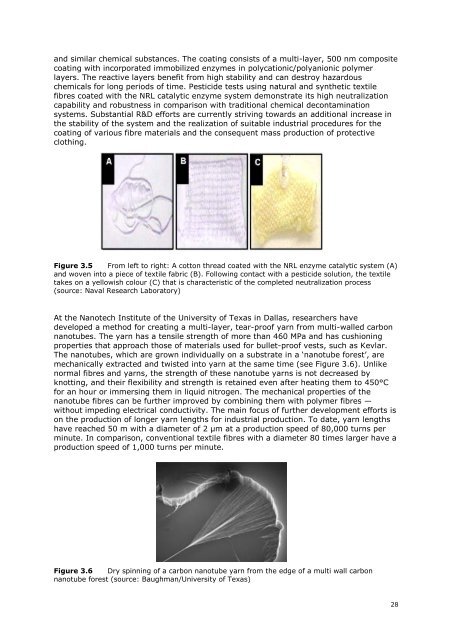Download - Nanowerk
Download - Nanowerk
Download - Nanowerk
You also want an ePaper? Increase the reach of your titles
YUMPU automatically turns print PDFs into web optimized ePapers that Google loves.
and similar chemical substances. The coating consists of a multi-layer, 500 nm composite<br />
coating with incorporated immobilized enzymes in polycationic/polyanionic polymer<br />
layers. The reactive layers benefit from high stability and can destroy hazardous<br />
chemicals for long periods of time. Pesticide tests using natural and synthetic textile<br />
fibres coated with the NRL catalytic enzyme system demonstrate its high neutralization<br />
capability and robustness in comparison with traditional chemical decontamination<br />
systems. Substantial R&D efforts are currently striving towards an additional increase in<br />
the stability of the system and the realization of suitable industrial procedures for the<br />
coating of various fibre materials and the consequent mass production of protective<br />
clothing.<br />
Figure 3.5 From left to right: A cotton thread coated with the NRL enzyme catalytic system (A)<br />
and woven into a piece of textile fabric (B). Following contact with a pesticide solution, the textile<br />
takes on a yellowish colour (C) that is characteristic of the completed neutralization process<br />
(source: Naval Research Laboratory)<br />
At the Nanotech Institute of the University of Texas in Dallas, researchers have<br />
developed a method for creating a multi-layer, tear-proof yarn from multi-walled carbon<br />
nanotubes. The yarn has a tensile strength of more than 460 MPa and has cushioning<br />
properties that approach those of materials used for bullet-proof vests, such as Kevlar.<br />
The nanotubes, which are grown individually on a substrate in a ‘nanotube forest’, are<br />
mechanically extracted and twisted into yarn at the same time (see Figure 3.6). Unlike<br />
normal fibres and yarns, the strength of these nanotube yarns is not decreased by<br />
knotting, and their flexibility and strength is retained even after heating them to 450°C<br />
for an hour or immersing them in liquid nitrogen. The mechanical properties of the<br />
nanotube fibres can be further improved by combining them with polymer fibres —<br />
without impeding electrical conductivity. The main focus of further development efforts is<br />
on the production of longer yarn lengths for industrial production. To date, yarn lengths<br />
have reached 50 m with a diameter of 2 µm at a production speed of 80,000 turns per<br />
minute. In comparison, conventional textile fibres with a diameter 80 times larger have a<br />
production speed of 1,000 turns per minute.<br />
Figure 3.6 Dry spinning of a carbon nanotube yarn from the edge of a multi wall carbon<br />
nanotube forest (source: Baughman/University of Texas)<br />
28

















